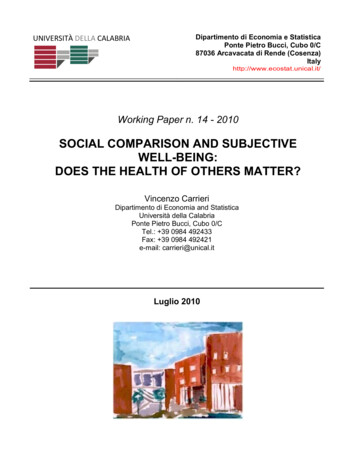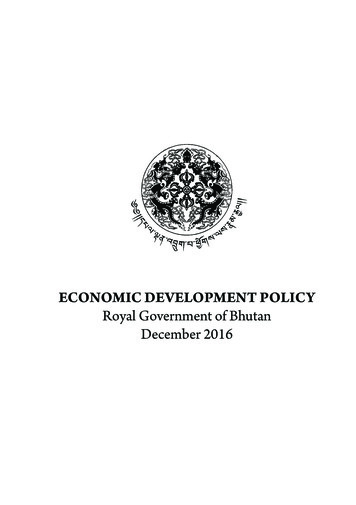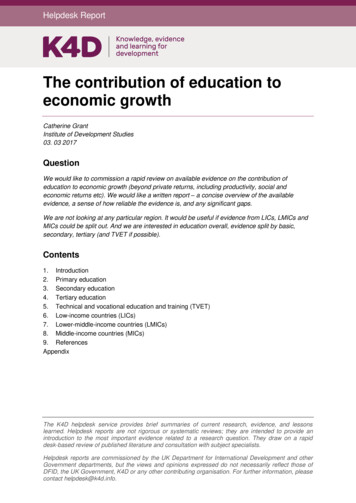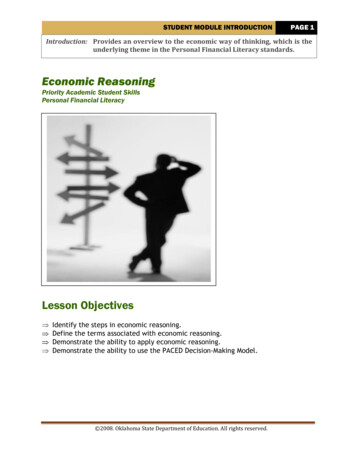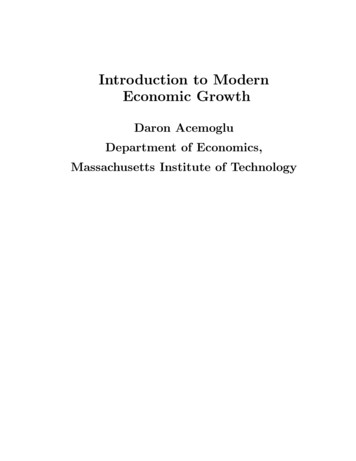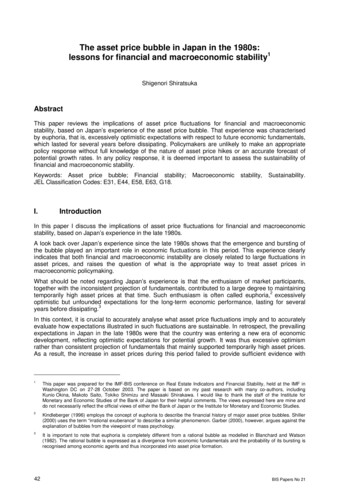
Transcription
NBER WORKING PAPER SERIESECONOMIC GROWTH AND SUBJECTIVE WELL-BEING:REASSESSING THE EASTERLIN PARADOXBetsey StevensonJustin WolfersWorking Paper 14282http://www.nber.org/papers/w14282NATIONAL BUREAU OF ECONOMIC RESEARCH1050 Massachusetts AvenueCambridge, MA 02138August 2008The authors would like to thank Gary Becker, David Blanchflower, Angus Deaton, Richard Easterlin,Carol Graham, Daniel Kahneman, Alan Krueger, David Laibson, Andrew Oswald, and Luis Rayofor useful discussions, and Gale Muller and his colleagues at Gallup for access to and help with theGallup World Poll. Rohak Doshi and Michael L. Woodford provided excellent research assistance.We would like to thank the Zicklin Center for Business Ethics Research and the Zell/Lurie Real EstateCenter for generous research support. The data and Stata programs used in this paper are availablefor download from the authors' homepages. The views expressed herein are those of the author(s) anddo not necessarily reflect the views of the National Bureau of Economic Research.NBER working papers are circulated for discussion and comment purposes. They have not been peerreviewed or been subject to the review by the NBER Board of Directors that accompanies officialNBER publications. 2008 by Betsey Stevenson and Justin Wolfers. All rights reserved. Short sections of text, not toexceed two paragraphs, may be quoted without explicit permission provided that full credit, including notice, is given to the source.
Economic Growth and Subjective Well-Being: Reassessing the Easterlin ParadoxBetsey Stevenson and Justin WolfersNBER Working Paper No. 14282August 2008JEL No. D6,I3,J1ABSTRACTThe "Easterlin paradox" suggests that there is no link between a society's economic development andits average level of happiness. We re-assess this paradox analyzing multiple rich datasets spanningmany decades. Using recent data on a broader array of countries, we establish a clear positive linkbetween average levels of subjective well-being and GDP per capita across countries, and find noevidence of a satiation point beyond which wealthier countries have no further increases in subjectivewell-being. We show that the estimated relationship is consistent across many datasets and is similarto the relationship between subject well-being and income observed within countries. Finally, examiningthe relationship between changes in subjective well-being and income over time within countries wefind economic growth associated with rising happiness. Together these findings indicate a clear rolefor absolute income and a more limited role for relative income comparisons in determining happiness.Betsey StevensonThe Wharton SchoolUniversity of Pennsylvania1454 Steinberg - Dietrich Hall3620 Locust WalkPhiladelphia, PA 19104and NBERbetseys@wharton.upenn.eduJustin WolfersBusiness and Public Policy DepartmentWharton School, University of Pennsylvania3620 Locust WalkRoom 1456 Steinberg-Deitrich HallPhiladelphia, PA 19104-6372and NBERjwolfers@wharton.upenn.edu
I.IntroductionEconomic growth has long been considered an important goal of economic policy, yet in recent years some havebegun to argue against further trying to raise the material standard of living, claiming that such increases will do little toraise well-being. These arguments are based on a key finding in the emerging literature on subjective well-being, calledthe “Easterlin paradox,” which suggests that there is no link between the level of economic development of a society andthe overall happiness of its members. In several papers Richard Easterlin has examined the relationship between happinessand GDP both across countries and within individual countries through time (1974, 1995, 2005a, 2005b). In both types ofanalysis he finds little significant evidence of a link between aggregate income and average happiness.In contrast, there is robust evidence that within countries those with more income are happier. These twoseemingly discordant findings—that income is an important predictor of individual happiness, yet apparently irrelevantfor average happiness—have spurred researchers to seek to reconcile them through models emphasizing referencedependent preferences and relative income comparisons (Easterlin, 1973, p. 4).2 Layard offers an explanation: “people areconcerned about their relative income and not simply about its absolute level. They want to keep up with the Joneses or ifpossible to outdo them” (Layard, 2005a, p. 45). While leaving room for absolute income to matter for some people,Layard and others have argued that absolute income is only important for happiness when income is very low. Layardargues, for example, that “once a country has over 15,000 per head, its level of happiness appears to be independent ofits income per head” (2003, p. 17).3The conclusion that absolute income has little impact on happiness has far-reaching policy implications. Ifeconomic growth does little to improve social welfare, then it should not be a primary goal of government policy. Indeed,Easterlin argues that his analysis of time trends in subjective well-being “undermine the view that a focus on economicgrowth is in the best interests of society” (2005c, p. 441). Layard argues for an explicit government policy of maximizingsubjective well-being (2005a).4 Moreover, he notes that relative income comparisons imply that each individual’s labor2Easterlin summarizes his findings:“In all societies, more money for the individual typically means more individual happiness. However, raising the incomes of alldoes not increase the happiness of all. The happiness-income relation provides a classic example of the logical fallacy ofcomposition—what is true for the individual is not true for society as a whole.The resolution of this paradox lies in the relative nature of welfare judgments. Individuals assess their material well-being, not interms of the absolute amount of goods they have, but relative to a social norm of what goods they ought to have (italics inoriginal).”Layard (1980, p. 737) is more succinct: “a basic finding of happiness surveys is that, though richer societies are not happier thanpoorer ones, within any society happiness and riches go together.” For a recent review of the use of reference-dependent preferencesto explain these observations, see Clark, Frijters, and Shields (2008).3For other arguments proposing a satiation point in happiness, see Veenhoven (1991) Clark, Frijters, and Shields (2008); Frey andStutzer (2002).4For a concurring view from the positive psychology movement, see Diener and Seligman (2004).1
effort imposes negative externalities on others (by shifting their reference points) and that these distortions would be bestcorrected by higher taxes on income or consumption.Evaluating these strong policy prescriptions demands a robust understanding of the true relationship betweenincome and well-being. Unfortunately, the present literature is based on fragile and incomplete evidence about thisrelationship. At the time the Easterlin paradox was first identified, few data were available to allow an assessment ofsubjective well-being across countries and through time. The difficulty of identifying a robust GDP-happiness link fromscarce data led some to confound the absence of evidence of such a link with evidence of its absence.The ensuing years have seen an accumulation of cross-country data recording individual life satisfaction andhappiness. These recent data (and a reanalysis of earlier data) suggest that the case for a link between economicdevelopment and happiness is quite robust. The key to our findings is a resolute focus on the magnitude of the subjectivewell-being-income gradient estimated within and across countries at a point in time as well as over time, rather than itsstatistical significance or insignificance.Our key result is that the estimated subjective well-being-income gradient is not only significant but alsoremarkably robust across countries, within countries, and over time. These comparisons between rich and poor membersof the same society, between rich and poor countries, and within countries through time as they become richer or poorerall yield similar estimates of the well-being-income gradient. Our findings both put to rest the earlier claim that economicdevelopment does not raise subjective well-being and undermine the possible role played by relative income comparisons.These findings invite a sharp reassessment of the stylized facts that have informed economic analysis ofsubjective well-being data. Across the world’s population, variation in income explains a sizable proportion of thevariation in subjective well-being. There appears to be a very strong relationship between subjective well-being andincome, which holds for both rich and poor countries, falsifying earlier claims of a satiation point at which higher GDPper capita is not associated with greater well-being.The rest of this paper is organized as follows. The first section provides some background on the measurement ofsubjective well-being and economic analysis of these data. Subsequent sections are organized around alternativemeasurement approaches to assessing the link between income and well-being. Thus, the second section comparesaverage well-being and income across countries. Whereas earlier studies focused on comparisons of small numbers ofindustrialized countries, newly available data allow comparisons across countries at all levels of development. Thesecomparisons show a powerful effect of national income in explaining variation in subjective well-being across countries.In the third section we confirm the earlier finding that richer people within a society are typically happier than their poorerbrethren. Because these national cross sections typically involve quite large samples, this finding is extremely statisticallysignificant and has not been widely disputed. However, Easterlin (1974) and others have argued strongly that the positiverelationship between income and subjective well-being within countries is much larger than that seen across countries.This argument is not borne out by the data: the well-being-income gradient measured within countries is similar to thatmeasured between countries. The paper’s fourth section extends our analysis to assessing national time-series movements2
in average well-being and income. Consistent time series measuring subjective well-being data are scarce, and the existingdata is noisy. These factors explain why past researchers have not found a link between economic growth and growth inhappiness. We reexamine three of the key case studies from previous research and find that a more careful assessment ofthe experiences of Japan, Europe, and the United States does not undermine the claim of a clear link between economicgrowth and happiness, a finding supported by repeated international cross-sections. Our point estimates suggest that thelink may be similar to that found in cross-country comparisons, although substantial uncertainty remains around theseestimates. The fifth section briefly explores alternative measures of well-being.II.Some Background on Subjective Well-Being and IncomeOur strategy in this paper is to use all of the important large-scale surveys now available to assess the relationshipbetween subjective well-being and happiness. These surveys typically involve questions probing happiness or lifesatisfaction. The World Values Survey, for example, asks, “Taking all things together, would you say you are: veryhappy; quite happy; not very happy; not at all happy?” and, “All things considered, how satisfied are you with your life asa whole these days?” Other variants of the question, such as that in the Gallup World Poll, employ a ladder analogy:interviewees are asked to imagine a ladder with each rung representing a successively better life. Respondents then reportthe “step” on the ladder that best represents their life.These questions (and many other variants) are typically clustered under the rubric of “subjective well-being”(Diener, 2006, pp. 399-400).5 Although the validity of these measures remains a somewhat open question, a variety ofevidence points to a robust correlation between answers to subjective well-being questions and more objective measuresof personal well-being. For example, answers to subjective well-being questions have been shown to be correlated withphysical evidence of affect such as smiling, laughing, heart rate measures, sociability, and electrical activity in the brain(Diener, 1984). Measures of individual happiness or life satisfaction are also correlated with other subjective assessmentsof well-being such as independent evaluations by friends, self-reported health, sleep quality, and personality (Diener,Lucas, and Scollon, 2006; Kahnman and Krueger, 2006). Subjective well-being is a function of both the individual’spersonality and his or her reaction to life events. One would therefore expect an individual’s happiness to be somewhatstable over time, and accurate measurements of subjective well-being to have high test-retest correlations, which indeedthey do (Eid and Diener, 2006). Self-reports of happiness have also been shown to be correlated in the expected directionwith changes in life circumstances. For example, an individual’s subjective well-being typically rises with marriage andincome growth and falls while going through a divorce.5Diener suggests that “subjective well-being refers to all of the various types of evaluations, both positive and negative, that peoplemake of their lives. It includes reflective cognitive evaluations, such as life satisfaction and work satisfaction, interest andengagement, and affective reactions to life events, such as joy and sadness. Thus, subjective well-being is an umbrella term for thedifferent valuations people make regarding their lives, the events happening to them, their bodies and minds, and the circumstances inwhich they live.”3
Although the results from each of these approaches suggest that cross-sectional comparisons of people within apopulation have some validity, there is less evidence about the validity of comparisons across populations, which can beconfounded by translation problems and cultural differences. Many researchers have argued for the possibility of abiologically based set of emotions that are universal to humans and appear in all cultures (Diener and Tov, 2008).Research has found that people across cultures clearly recognize emotions such as anger, sadness, and joy when displayedin others’ facial expressions (Ekman and Friesen,1971; Ekman , et al., 1987). Studies have also found that when peoplearound the globe are asked about what is required for more happiness or life satisfaction, the answers are strikinglyuniform: money, health, and family are said to be the necessary components of a good life (Easterlin, 1974). Diener andTov (2008) argue that it is this possibility of biologically based universal emotions that suggests that well-being can becompared across societies.A similar argument applies to making comparisons of subjective well-being within countries over time. Onedifficulty with time-series assessments is the possibility that small changes in how people perceive or answer questionsabout their happiness may be correlated with changes in the outcomes—such as income—whose relationship withsubjective well-being one wishes to assess. The evidence regarding aggregate changes in happiness over time isinconsistent. Aggregate happiness has been shown to fall when unemployment and inflation rise, and to move in theexpected direction with the business cycle (Di Tella, MacCulloch, and Oswald, 2003; Wolfers, 2003). However, onaverage, women in both the United States and Europe report declining happiness relative to men over recent decades, afinding that is difficult to reconcile with changes in objective conditions (Stevenson and Wolfers, 2007). Finally, thiscurrent paper is motivated by a desire to better understand the failure of past studies to isolate a link between happinessand economic growth.A largely under-acknowledged problem in making intertemporal comparisons is simply the difficulty incompiling sufficiently comparable data. For instance, Smith (1986) shows that small changes in the ordering of questionson the U.S. General Social Survey led to large changes in reported happiness. These same data seem to show importantday of week and seasonal cycles as well. Another difficulty with intertemporal comparisons is that attempts to cobbletogether long time series (such as for Japan, the United States, or China) often involve important coding breaks. Many ofthese issues simply add measurement error, making statistically significant findings more difficult to obtain. However,when scarce data are used to make strong inferences about changes in well-being over decades, even small amounts ofmeasurement error can lead to misleading inferences.To date, much of the economics literature assessing subjective well-being has tended to use measures of “lifesatisfaction” and “happiness” interchangeably. The argument for doing so is that these alternative measures of well-beingare highly correlated and have similar covariates. However, they capture somewhat different concepts, with happinessmore related to affect whereas satisfaction is more evaluative. The psychology literature has tended to treat questionsprobing affect as distinct from more evaluative assessments. We will consider both the income-happiness and incomesatisfaction links in parallel. A subtle measurement issue is also involved, in that many of the surveys asking individuals4
about their happiness provide a shorter scale of answers (such as “very happy,” “pretty happy,” and “not so happy”) thando those asking typical life satisfaction questions (which often use the “ladder” technique described above).A final measurement issue to consider is the likely functional form of the relationship between subjective wellbeing and income. Most early studies considered the relationship between the level of absolute income and the level ofhappiness, and thus often found a curvilinear relationship. In some cases the lack of evidence of a clear linear relationshipbetween GDP per capita and happiness led to theories of a satiation point, beyond which more income would not increasehappiness. A more natural starting point might be to represent well-being as a function of the logarithm of income ratherthan absolute income. And indeed, recent research has shown that within countries “the supposed attenuation at higherincome levels of the happiness-income relation does not occur when happiness is regressed on log income, rather thanabsolute income” (Easterlin, 2001, p. 468). However, if happiness is linearly related to log income in the within-countrycross section, then cross-country studies should also examine the relationship between average levels of subjective wellbeing and average levels of log income. If economic development raises individual incomes equiproportionately, thenaverage log income will rise or fall in tandem with the log of average income. Thus, most of our analysis assesses therelationship across countries between well-being and the log of GDP per capita, which is (surprisingly enough) adeparture from much of the literature.6 Throughout our analysis we make heavy use of bivariate scatterplots andnonparametric regression techniques in order to allow the reader to assess the appropriate functional forms visually.Finally, as in the existing literature, our analysis of the relationship between happiness and income involves anassessment of correlations rather than an attempt to establish tight causal links. Thus, our aim is simply to sort out thestylized facts about the link between income and well-being. Several interesting variants of the question could be asked—such as whether it is GDP, broader measures of economic development, or alternatively, changes in output or inproductivity that drive happiness. Unfortunately, we lack the statistical power to resolve these questions.III.Cross-Country Comparisons of Income and Well-BeingIn his seminal 1974 paper Easterlin asked whether “richer countries are happier countries” (1974, p. 104).Examining two international datasets, he found a relationship across countries between aggregate happiness and incomethat he described as “ambiguous” and, although perhaps positive, small (ibid., p.108). Subsequent research began to showa more robust positive relationship between a country’s income and the happiness of its people, leading Easterlin to laterconclude that “a positive happiness-income relationship typically turns up in international comparisons” (1995, p. 42).However, this relationship has been argued as prevailing only over low levels of GDP per capita; once wealthy countrieshave satisfied basic needs, they have been described as on the “‘flat of the curve,’ with additional income buying little ifany extra happiness” (Clark, Frijters, and Shields, 2008, p. 96). Although the literature has largely settled on the view that6Previous authors examining the relationship between well-being and log GDP include Easterlin (1995), Leigh and Wolfers (2006),and Deaton (2008); however, explicit discussion of the appropriate functional form is quite rare.5
aggregate happiness rises with GDP for low-income countries, there is much less consensus on the magnitude of thisrelationship, or on whether a satiation point exists beyond which further increases in GDP per capita are associated withno change in aggregate happiness (Deaton, 2008).7The early cross-country studies of income and happiness tended to be based on only a handful of countries, oftenwith rather similar income per capita, and hence did not lend themselves to definitive findings. In addition, as therelationship between subjective well-being and the log of income is approximately linear, the analysis in terms of absolutelevels of GDP per capita likely contributed to the lack of clarity around the relationship between income and happinessamong wealthier countries. As we will show, new large-scale datasets covering many countries point to a clear, robustrelationship between GDP per capita and average levels of subjective well-being in a country. Furthermore, we find noevidence that countries become satiated—the positive income-happiness relationship holds for both developed anddeveloping nations.Our macroeconomic analysis focuses on measures of real GDP per capita measured at purchasing power parity.For most countries we use the most recent data from the World Bank’s World Development Indicators database; wherewe are missing data, we refer to the Penn World Tables (version 6.2) and, failing that, the CIA Factbook. For earlier yearswe use data from Maddison (2007).8 The average of log income per person may be a more desirable aggregate than thelog of average income, and so in some specifications we also account for the difference between these measures (alsoknown as the mean log deviation).Measuring average levels of subjective well-being is somewhat more difficult, as this typically involvesaggregating individual responses to a qualitative question. Moreover, we wish to make comparisons across surveys thatcontain subjective well-being questions with varying numbers of categories for the responses. To do this, we need toconvert the subjective well-being measures to a normalized measure, which we do through the use of ordered probitregressions of happiness on a series of country (or country-year) fixed effects (with no other controls), and then treat thesefixed effects as average levels of well-being within a country (or country-year).9 Appendix A compares our ordered probitindex with four alternative approaches to cardinalizing both life satisfaction and happiness, demonstrating that thesealternatives yield highly correlated well-being aggregates. The distinct advantage of the ordered probit is that coefficientscan be interpreted relative to the dispersion of the distribution of latent well-being in the population. As such, our orderedprobit index should be interpreted as highlighting differences in average levels of happiness or life satisfaction betweencountries, relative to the pooled within-country standard deviation.7Deaton finds no evidence of a satiation point. His analysis of the 2006 Gallup World Poll finds a strong relationship between logGDP and happiness that is, if anything, stronger among high-income countries.8When filling in missing years, we interpolate using the annual percentage changes listed in the Penn World Tables. When filling inmissing countries, we apply the ratio of a country’s GDP per capita to U.S GDP per capita, using data from the Penn World Tables orthe CIA Factbook, to the World Bank data.9Throughout, we use suggested surveys weights to ensure our estimates are nationally representative for each country in each wave.6
We present our analysis chronologically, so that the reader may see how the literature has progressed. To alloweasy visual comparisons, we use a similar scale when graphing happiness and GDP and try to keep this scale consistentthroughout the paper.The top row of graphs in Figure 1 shows the three earliest cross-country comparisons of subjective well-being ofwhich we are aware. Each of these comparisons is based on only four to nine countries, which were similar in terms ofeconomic development. As a consequence, these comparisons yield quite imprecise estimates of the link betweenhappiness and GDP. We have provided two useful visual devices to aid in interpretation: a dashed line showing theordinary least squares regression line (our focus), and a shaded area that shows a central part of the happiness distribution,with a width equal to the cross-sectional standard deviation.The graphs in the second row of Figure 1 show the cross-country comparisons presented by Easterlin (1974).10Analyzing the 1960 data, Easterlin argues that “the association between wealth and happiness indicated by Cantril’sinternational data is not so clear-cut . The inference about a positive association relies heavily on the observations forIndia and the United States” (ibid., p. 108). 11 Turning to the 1965 World Survey III data, Easterlin argues that “The resultsare ambiguous . If there is a positive association between income and happiness, it is certainly not a strong one” (ibid.).Rather than highlighting the positive association suggested by the regression line, he argues that “what is perhaps moststriking is that the personal happiness ratings for 10 of the 14 countries lie virtually within a half a point of the midpointrating of 5 [on the raw 0-10 scale] . The closeness of the happiness ratings implies also that a similar lack of associationwould be found between happiness and other economic magnitudes” (ibid., p. 106). The clustering of countries within theshaded area on the chart gives a sense of this argument. However, the ordered probit index is quite useful here inquantifying the differences in average levels of happiness across countries relative to the within-country variation. Unlikethe raw data, the ordered probit suggests quite large differences in well-being relative to the cross-sectional standarddeviation. Similarly, the use of log income rather than absolute income highlights the linear-log relationship. Finally,Easterlin mentions briefly the 1946 and 1949 data shown in the top row of Figure 1, noting that “the results are similar if there is a positive association among countries between income and happiness it is not very clear” (ibid., p. 108).Although the correlation between income and happiness in these early surveys is not especially convincing, thisdoes not imply that income has only a minor influence on happiness, but rather that other factors (possibly includingmeasurement error) also affect the national happiness aggregates. Even so, three of these five datasets suggest astatistically significant relationship between happiness and the natural logarithm of GDP per capita. More important, thepoint estimates reveal a positive relationship between well-being and income, and a precision-weighted average of thesefive regression coefficients is 0.45, which is comparable to the sort of well-being-GDP gradient suggested in crosssectional comparisons of rich and poor people within a society (a theme we explore further below).10We plot the ordered probit index, whereas Easterlin graphs the mean response.Following Cantril (1965), Easterlin also notes that “the values for Cuba and the Dominican Republic reflect unusual politicalcircumstances—the immediate aftermath of a successful revolution in Cuba and prolonged political turmoil in the DominicanRepublic.”117
We have also located several other surveys from the mid-1960s through the 1970s that show a similar pattern. Inparticular, the ten-nation “Images of the World in the Year 2000” study, conducted in 1967, and the twelve-nation GallupKettering Survey, from 1975, both yield further evidence consistent with an important and positive well-being-GDPgradient. Subsequent cross-country data collections have become increasingly ambitious, and analysis of these data hasmade the case for a linear-log relationship between subjective well-being and GDP per capita even stronger, while alsolargely confirming that the magnitudes suggested by these early studies were quite accurate.Figure 2 presents data on life satisfaction from each wave of the World Values Survey separately; illustrating theaccumulation of new data through time (We turn to the data on happiness from this survey below, in Figure 5).12 In theearly waves of the survey the sample consisted mostly of wealthy countries; given the limited variation in income, thesesamples yielded suggestive, but not definitive, evidence of a link between GDP and life satisfaction. As the sampleexpanded, the relationship became cle
3 in average well-being and income. Consistent time series measuring subjective well-being data are scarce, and the existing data is noisy. These factors explain why past researchers ha

